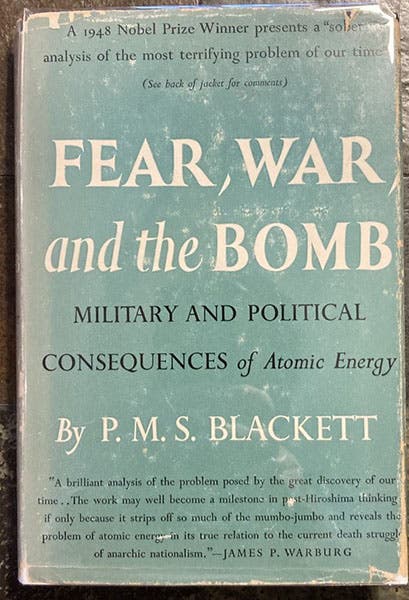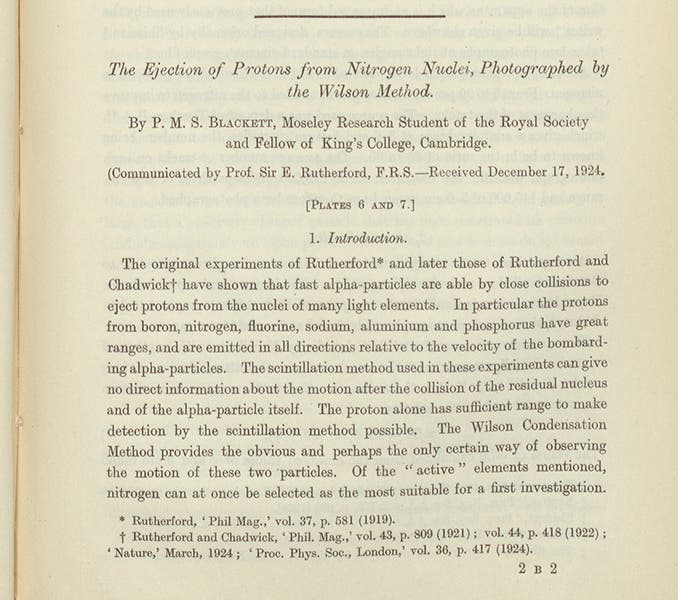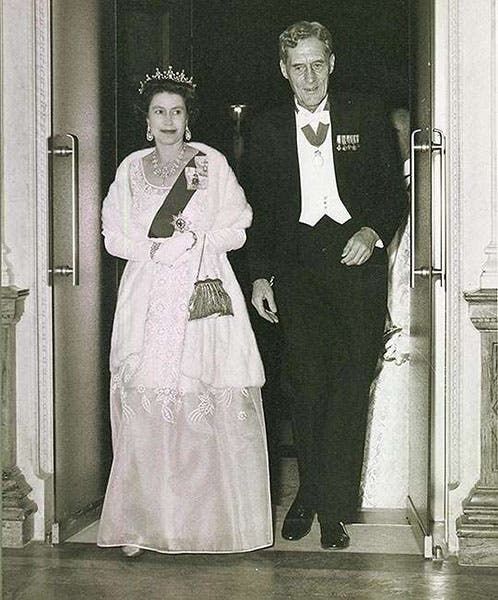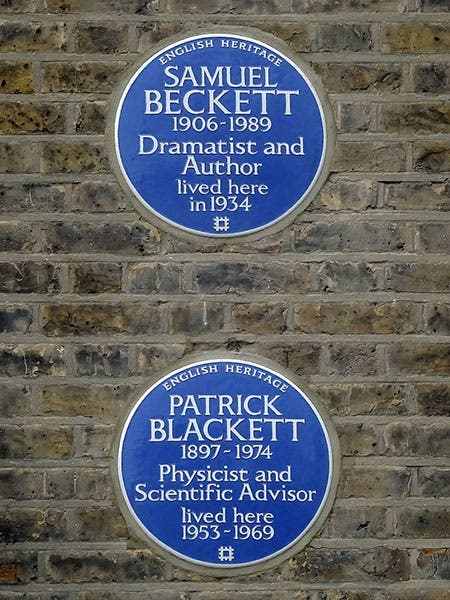Scientist of the Day - Patrick Blackett
Patrick M.S. Blackett, an English particle physicist and science policy maker, was born Nov. 18, 1897. He spent the four years of World War I in the Royal Navy, as a Cadet, where he surprisingly received an excellent engineering education. The Navy sent him to Cambridge for six months after the war, where he resigned his commission and took up residence at the Cavendish Lab, run by Ernest Rutherford, and turned himself into a physicist. Rutherford in 1919 had discovered evidence for the existence of a positively charged nuclear particle, a proton, but his evidence was in the form of scintillations on a screen, not very convincing to some. Blackett learned how to use the cloud chamber, invented by C.T.R. Wilson at the Cavendish in 1912, and indeed perfected the instrument; by 1925, he had recorded many interactions of alpha particles with nitrogen atoms, where a nitrogen atom absorbed an alpha particle and spit out a proton, transmuting at the same time into an oxygen atom. Blackett published some of the more stunning cloud-chamber photographs in the Proceedings of the Royal Society of London in 1925 (second and third images), and his career was off and running.

Cloud chamber tracks showing alpha particles impacting nitrogen atoms, with the occasional production of a proton and the transmutation iof nitrogen into oxygen, detail of a plate accompanying a paper by Patrick M.S. Blackett in the Proceedings of the Royal Society of London, vol. A107, 1925 (Linda Hall Library)
In 1929, Paul Dirac had predicted the possibility of antimatter, specifically anti-electrons, or positrons, as they would eventually be called. His prediction was purely a result of his relativistic quantum mechanics, and had no experimental basis, so Blackett (with the help of an Italian vsitor, Giuseppe Occhialini), went looking, again with the help of a modified cloud chamber. Blacket suspected that the newly discovered cosmic rays were particles, and not gamma rays (as Robert Millikan at Caltech maintained). Blackett thought that a cosmic particle travelling very fast might have the energy to strike a nucleus and create an electron-positron pair, as Dirac predicted. They installed a magnet around the cloud chamber, to make the particles curve, and rigged the cloud chamber to a Geiger counter, so that the camera was triggered only when the Geiger counter detected an interaction. As a result, their photographs showed interactions nearly every time. They took thousands, and by 1932, 8 of those showed what appeared to be a new particle with the mass of an electron but curving in the direction of a positively charged particle. They had discovered the positron. But while Blackett, a very careful experimenter, checked and double-checked the results, a young American working for Millikan, Carl Anderson, detected positive electrons in his cloud chamber at Caltech in August of 1932, and he published his results first, in 1933. Anderson's discovery was purely fortuitous – he did not even know of Dirac's prediction. But in 1936, Anderson received the Noble Prize in Physics, and Blackett and Occhialini did not, which irritated the British physics community no end, although Blackett never complained or showed any concern. His own Nobel Prize would come in 1948, when he was finally recognized for his break-through work in particle physics.
During the Second World War, Blackett worked on radar, and a new bomb sight, and was a member of the MAUD committee that determined in 1941 that an atomic bomb was feasible. Blackett however was the only member of the committee that was opposed to England working on a bomb. As the war progressed, he soured on British aerial warfare policy, and was especially disturbed by the late-war practice of bombing civilian populations, as with Dresden. Blackett turned his attention to the U-boat menace, and he was instrumental in establishing policy that helped minimize that threat after 1943.

Dust jacket of Fear, War, and the Bomb, by Patrick M.S. Blackett, Whittlesey House, 1949 (author’s collection)
After the War, Blackett became increasingly involved in science policy. He had always been a Socialist, and he was opposed to excluding the Soviet Union from the exchange of scientific information, especially when it involved nuclear weapons. In the same year that he received his Nobel Prize, he published a book, Military and Political Consequences of Atomic Energy (in the U.S. edition, 1949, it had the more dramatic title: Fear, War and the Bomb, fourth image), in which he argued that atomic weapons would not put an end to conventional warfare, criticized the bombing policies of the War, especially when it impacted civilians, and claimed that the reason why atomic bombs were dropped on Hiroshima and Nagasaki was solely to prompt an early surrender of Japan to the U.S. and prevent Japan from falling to the Soviets. He attacked the notion of a preemptive nuclear first strike, as some American strategists were advocating. The book outraged Americans, and many British, but fifteen years later, Blackett's ideas were more acceptable and many of his recommendations were in place.
Blackett had left Cambridge in 1933 – chafing under Rutherford's iron rule – and ran labs at Birkbeck College in London and in Manchester, and he eventually settled in London, near the corridors of power. At Manchester and in London, he worked on developing a sensitive magnetometer that could detect the orientation of residual magnetic fields in the Earth's rocks. The instrument was essential in making possible the study of paleomagnetism, which eventually established that the Earth's crust is in motion, leading to the discovery of sea-floor spreading and plate tectonics.
In his final move to London, in 1953, Blackett took up residence at 48 Paultons Square in Chelsea. Presumably he knew that a previous resident was the playwright, Samuel Beckett. Visitors nowadays are aware of the fact, because there are two blue plaques on the front of the house, one for Beckett and one for Blackett. I am guessing that this is not a singular occurrence – that there are other houses that sport two blue plaques – but it is the only one I know of.
Dust jacket of Blackett: Physics, War, and Politics in the Twentieth Century, by Mary Jo Nye, 2004 (author’s collection)
There is an excellent biography: Blackett: Physics, War, and Politics in the Twentieth Century (2004), by the incomparable historian of science, Mary Jo Nye. I highly recommend it for those who want to better understand and appreciate the complex life and thought of this rare individual. The dust jacket (seventh image) also has my favorite photograph of Blackett, which I would not find anywhere else, even in the National Portrait Gallery, which has several dozen photos of Blackett, including the one that leads off this essay.
William B. Ashworth, Jr., Consultant for the History of Science, Linda Hall Library and Associate Professor emeritus, Department of History, University of Missouri-Kansas City. Comments or corrections are welcome; please direct to ashworthw@umkc.edu.










